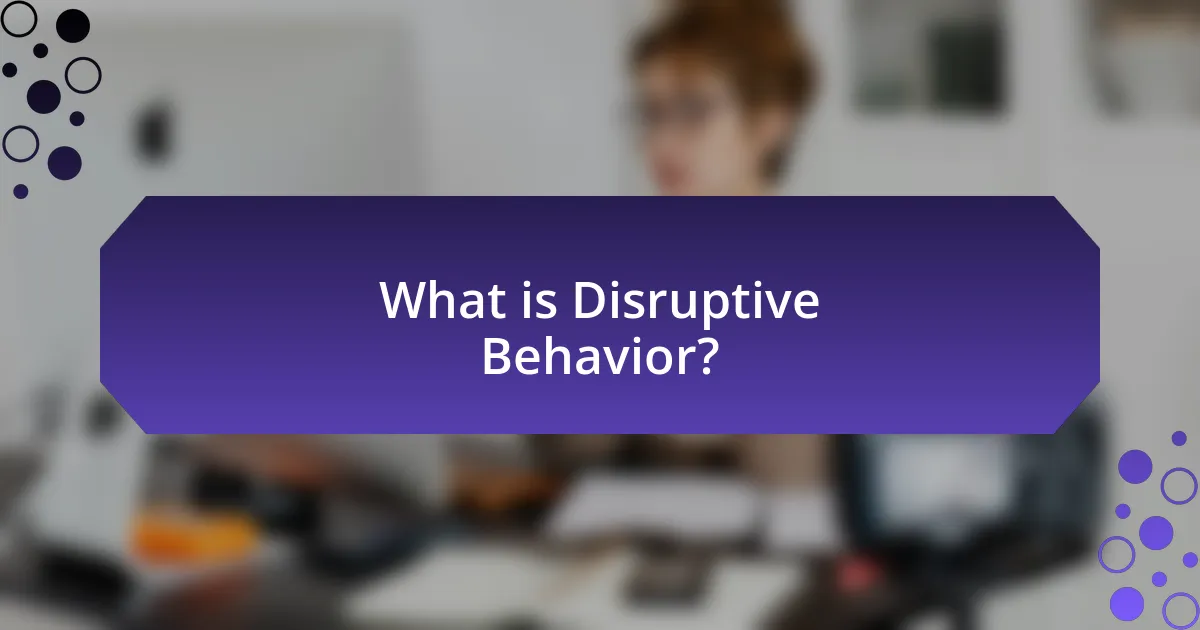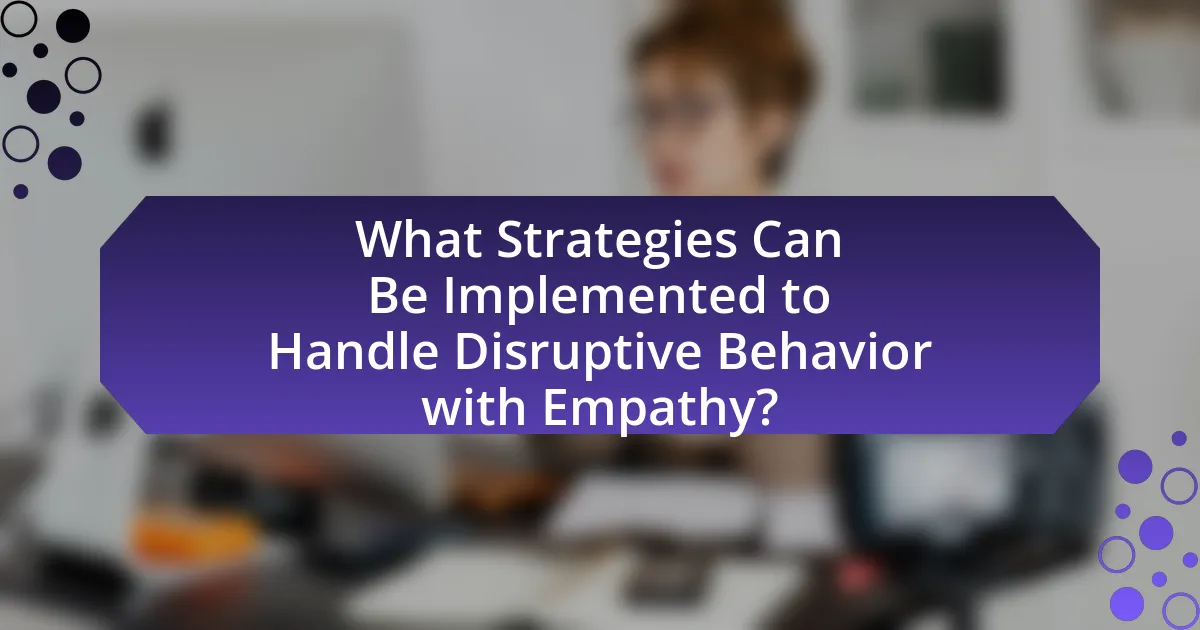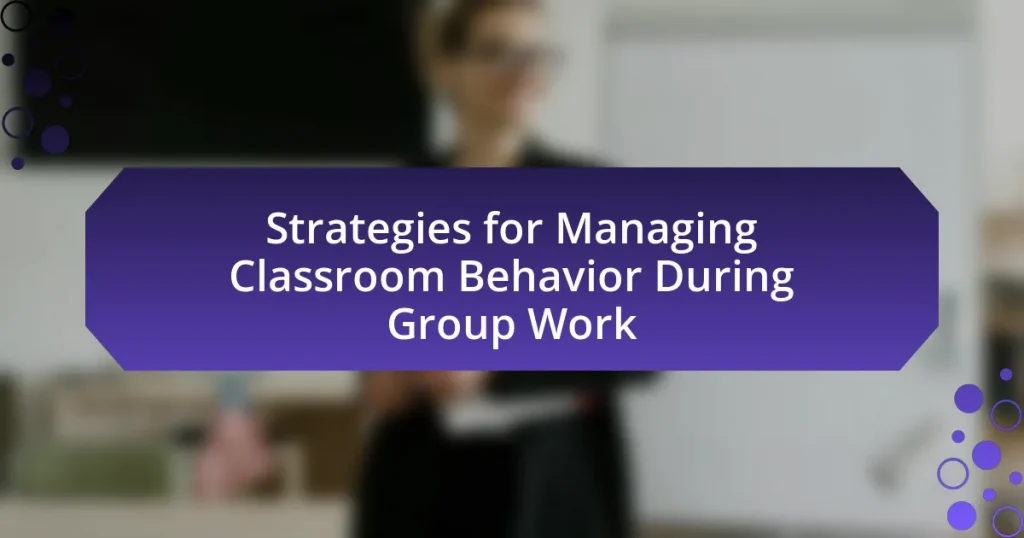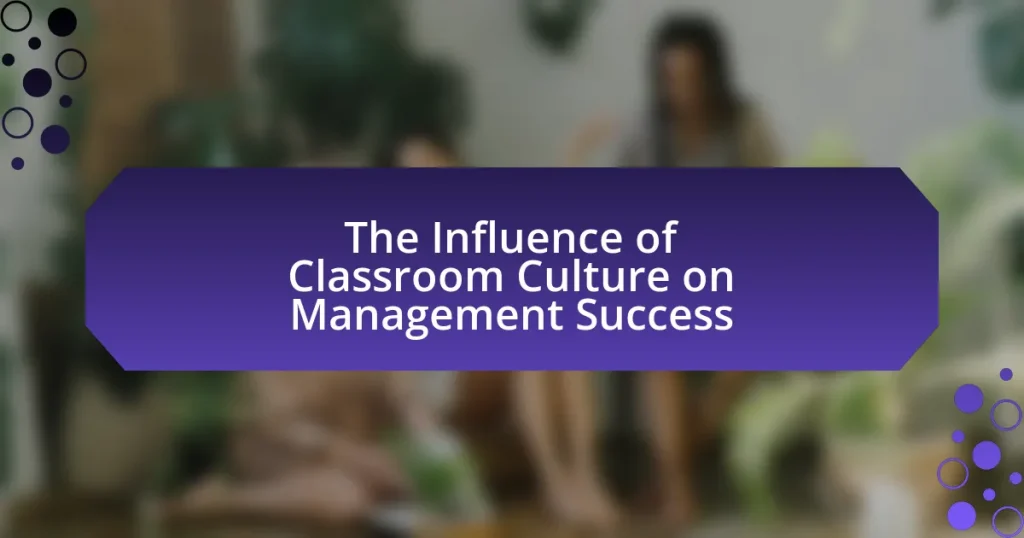Disruptive behavior encompasses actions that interrupt the normal functioning of groups or environments, manifesting in various contexts such as classrooms, workplaces, and social settings. This article explores the definition, characteristics, and potential causes of disruptive behavior, emphasizing the importance of addressing it to maintain a conducive atmosphere for learning and interaction. It highlights the role of empathy in managing such behavior, detailing strategies for effective communication, conflict resolution, and the creation of supportive environments. Additionally, the article discusses practical tips for handling disruptive incidents and the significance of follow-up actions to prevent recurrence.

What is Disruptive Behavior?
Disruptive behavior refers to actions that interfere with the normal functioning of a group or environment, often causing disturbances or distractions. This type of behavior can manifest in various settings, such as classrooms, workplaces, or social gatherings, and may include yelling, interrupting, or engaging in inappropriate conduct. Research indicates that disruptive behavior can negatively impact group dynamics and individual performance, highlighting the importance of addressing such actions effectively.
How can we define disruptive behavior in various contexts?
Disruptive behavior can be defined as actions that interrupt or interfere with the normal functioning of a group or environment. In educational settings, disruptive behavior may include talking out of turn, using electronic devices during class, or engaging in physical altercations, which can hinder the learning process. In workplaces, such behavior might manifest as constant interruptions during meetings, inappropriate comments, or refusal to follow established protocols, negatively impacting productivity and team dynamics. In social contexts, disruptive behavior can involve loud or aggressive actions that disturb public peace, such as excessive noise or confrontational interactions. Each context highlights the importance of understanding the specific nature of disruptive behavior to effectively address and manage it.
What are the common characteristics of disruptive behavior?
Common characteristics of disruptive behavior include aggression, defiance, and noncompliance. Aggression manifests as physical or verbal hostility towards others, while defiance involves openly resisting authority or rules. Noncompliance is characterized by refusal to follow instructions or adhere to established norms. These behaviors often disrupt social interactions and learning environments, leading to negative consequences for both the individual exhibiting the behavior and those around them. Research indicates that such behaviors can stem from underlying issues such as emotional distress or unmet needs, highlighting the importance of addressing the root causes to effectively manage and mitigate disruptive behavior.
Why is it important to address disruptive behavior?
Addressing disruptive behavior is crucial because it maintains a conducive environment for learning and interaction. When disruptive behavior is not addressed, it can lead to a decline in overall group morale, hinder the educational process, and create a negative atmosphere that affects all participants. Research indicates that classrooms with high levels of disruption experience lower academic performance and increased stress among students and teachers. By addressing such behavior promptly, educators can foster a more respectful and productive environment, ultimately enhancing the learning experience for everyone involved.
What are the potential causes of disruptive behavior?
Disruptive behavior can stem from various potential causes, including environmental factors, psychological issues, and social influences. Environmental factors such as chaotic home environments or inconsistent parenting styles can lead to a lack of stability, prompting disruptive actions. Psychological issues, including attention-deficit/hyperactivity disorder (ADHD) or anxiety disorders, can also manifest as disruptive behavior, as individuals may struggle to regulate their emotions or impulses. Additionally, social influences, such as peer pressure or exposure to negative role models, can encourage individuals to engage in disruptive actions to gain acceptance or attention. These causes highlight the complexity of disruptive behavior and the need for a nuanced understanding when addressing it.
How do environmental factors contribute to disruptive behavior?
Environmental factors significantly contribute to disruptive behavior by influencing an individual’s emotional and psychological state. For instance, high levels of noise, overcrowding, and lack of resources in a classroom or home environment can lead to increased stress and frustration, which may manifest as disruptive actions. Research indicates that children exposed to chaotic environments are more likely to exhibit behavioral issues, as demonstrated in a study published in the Journal of Abnormal Child Psychology, where authors found a correlation between environmental instability and increased aggression in children. Thus, the quality of the environment plays a crucial role in shaping behavior, highlighting the need for supportive and structured settings to mitigate disruptive tendencies.
What role do individual differences play in disruptive behavior?
Individual differences significantly influence disruptive behavior by affecting how individuals respond to social situations and stressors. Factors such as personality traits, emotional regulation, and cognitive styles contribute to variations in behavior, with research indicating that individuals with high levels of impulsivity or low emotional intelligence are more prone to exhibit disruptive actions. For instance, a study published in the Journal of Abnormal Psychology found that children with attention-deficit/hyperactivity disorder (ADHD), characterized by individual differences in attention and impulse control, often display higher rates of disruptive behavior compared to their peers. This highlights the importance of recognizing and addressing these individual differences when managing disruptive behavior effectively.

How does Empathy Play a Role in Managing Disruptive Behavior?
Empathy plays a crucial role in managing disruptive behavior by fostering understanding and connection between individuals. When caregivers or educators demonstrate empathy, they can better identify the underlying causes of disruptive actions, such as emotional distress or unmet needs. Research indicates that empathetic responses can de-escalate conflicts and promote positive behavior changes, as individuals feel heard and validated. For instance, a study published in the Journal of Educational Psychology found that students who perceived their teachers as empathetic were less likely to engage in disruptive behavior, highlighting the effectiveness of empathy in creating a supportive environment.
What is empathy and why is it crucial in handling disruptive behavior?
Empathy is the ability to understand and share the feelings of others, which is crucial in handling disruptive behavior because it fosters connection and de-escalation. When individuals exhibiting disruptive behavior feel understood, they are more likely to calm down and engage in constructive dialogue. Research indicates that empathetic responses can reduce aggression and promote cooperation, as shown in a study published in the Journal of Personality and Social Psychology, where participants who received empathetic communication were less likely to retaliate after experiencing provocation. Thus, empathy not only aids in managing immediate disruptions but also contributes to a more positive and collaborative environment.
How can empathy improve communication with individuals exhibiting disruptive behavior?
Empathy can significantly improve communication with individuals exhibiting disruptive behavior by fostering understanding and reducing conflict. When a person demonstrates empathy, they actively listen and validate the feelings of the disruptive individual, which can de-escalate tension and create a more constructive dialogue. Research indicates that empathetic communication leads to better conflict resolution outcomes, as it encourages cooperation and trust. For instance, a study published in the Journal of Applied Psychology found that empathetic leaders were more effective in managing team conflicts, resulting in improved team dynamics and performance. By recognizing and addressing the emotional needs of individuals displaying disruptive behavior, empathy facilitates a more positive interaction and promotes behavioral change.
What are the emotional benefits of using empathy in conflict resolution?
Using empathy in conflict resolution fosters emotional benefits such as increased understanding, reduced hostility, and enhanced relationships. When individuals actively listen and validate each other’s feelings, it creates a safe environment for open communication, which can lead to de-escalation of tensions. Research indicates that empathy can lower stress levels and promote emotional regulation, allowing parties to approach conflicts with a clearer mindset. Furthermore, empathetic interactions can strengthen interpersonal bonds, as individuals feel valued and respected, ultimately contributing to more constructive outcomes in conflict situations.
How can empathy be effectively applied in real-life situations?
Empathy can be effectively applied in real-life situations by actively listening to others, validating their feelings, and responding with compassion. For instance, in a workplace conflict, a manager can demonstrate empathy by acknowledging an employee’s frustrations, which fosters a supportive environment and encourages open communication. Research indicates that empathetic leadership enhances team cohesion and productivity, as shown in a study published in the Journal of Business Ethics, where leaders who practiced empathy saw a 20% increase in employee satisfaction. This evidence supports the notion that applying empathy in real-life interactions not only resolves conflicts but also strengthens relationships.
What techniques can be used to demonstrate empathy towards disruptive individuals?
To demonstrate empathy towards disruptive individuals, active listening and validating their feelings are effective techniques. Active listening involves giving full attention to the individual, acknowledging their emotions, and responding thoughtfully, which can help de-escalate tension. Validating feelings means recognizing and affirming the individual’s emotions, even if their behavior is disruptive, which fosters a sense of understanding and connection. Research indicates that these techniques can lead to improved communication and reduced conflict, as they create an environment where individuals feel heard and respected.
How can active listening enhance empathetic responses?
Active listening enhances empathetic responses by fostering a deeper understanding of the speaker’s emotions and perspectives. When individuals engage in active listening, they focus entirely on the speaker, which allows them to accurately interpret verbal and non-verbal cues. This attentiveness leads to a more profound emotional connection, enabling the listener to respond with greater empathy. Research indicates that active listening can improve interpersonal relationships and emotional intelligence, as it encourages individuals to validate others’ feelings and experiences. For instance, a study published in the Journal of Applied Psychology found that active listening significantly increases the listener’s ability to empathize, resulting in more supportive and constructive interactions.

What Strategies Can Be Implemented to Handle Disruptive Behavior with Empathy?
To handle disruptive behavior with empathy, one effective strategy is to actively listen to the individual exhibiting the behavior. Active listening involves giving full attention, acknowledging feelings, and responding thoughtfully, which can de-escalate tensions and foster understanding. Research indicates that when individuals feel heard, they are more likely to cooperate and engage positively. Additionally, employing a calm and non-confrontational tone can help create a safe environment for dialogue, further reducing the likelihood of escalation. Implementing these strategies not only addresses the immediate disruptive behavior but also builds a foundation for future positive interactions.
What are some effective strategies for addressing disruptive behavior empathetically?
Effective strategies for addressing disruptive behavior empathetically include active listening, validating feelings, and setting clear boundaries. Active listening involves giving full attention to the individual exhibiting disruptive behavior, which helps them feel heard and understood. Validating feelings means acknowledging the emotions behind the behavior, which can de-escalate tension and foster a supportive environment. Setting clear boundaries provides structure and expectations, allowing individuals to understand acceptable behavior while still feeling respected. Research indicates that empathetic approaches can lead to improved relationships and reduced conflict, as seen in studies on conflict resolution and emotional intelligence.
How can setting clear expectations help in managing disruptive behavior?
Setting clear expectations helps in managing disruptive behavior by providing individuals with a defined framework of acceptable conduct. When expectations are communicated effectively, individuals understand the boundaries and consequences associated with their actions, which can reduce instances of disruption. Research indicates that environments with established norms and guidelines experience fewer behavioral issues, as individuals are more likely to adhere to the expected standards when they are clearly articulated. For example, a study published in the Journal of Educational Psychology found that classrooms with well-defined rules saw a significant decrease in disruptive behaviors, highlighting the importance of clarity in expectations for fostering a positive environment.
What role does positive reinforcement play in encouraging appropriate behavior?
Positive reinforcement plays a crucial role in encouraging appropriate behavior by providing rewards or incentives that increase the likelihood of desired actions being repeated. When individuals receive positive feedback or tangible rewards for exhibiting appropriate behavior, they are more motivated to continue those behaviors in the future. Research indicates that positive reinforcement can lead to a 30% increase in the frequency of desired behaviors, as demonstrated in studies on behavior modification techniques in educational settings. This approach not only fosters a supportive environment but also enhances the overall learning experience by promoting engagement and compliance.
How can we create a supportive environment to reduce disruptive behavior?
Creating a supportive environment to reduce disruptive behavior involves implementing clear communication, establishing consistent expectations, and fostering positive relationships. Clear communication ensures that individuals understand the rules and the rationale behind them, which can decrease confusion and frustration that often lead to disruptive actions. Establishing consistent expectations provides a structured framework that helps individuals know what is acceptable behavior, thereby reducing instances of disruption. Fostering positive relationships through empathy and understanding encourages individuals to feel valued and respected, which can significantly lower the likelihood of disruptive behavior. Research indicates that environments characterized by supportive interactions and clear guidelines lead to improved behavior outcomes, as seen in studies conducted by the Collaborative for Academic, Social, and Emotional Learning (CASEL), which emphasize the importance of social-emotional learning in creating positive school climates.
What practices can foster a culture of empathy in educational or workplace settings?
Practices that can foster a culture of empathy in educational or workplace settings include active listening, training programs focused on emotional intelligence, and creating safe spaces for open dialogue. Active listening encourages individuals to fully engage with others’ perspectives, which enhances understanding and connection. Training programs that emphasize emotional intelligence equip participants with skills to recognize and manage their own emotions while empathizing with others, leading to improved interpersonal relationships. Additionally, establishing safe spaces for open dialogue allows individuals to express their feelings and experiences without fear of judgment, promoting a supportive environment. Research indicates that organizations with strong empathy practices report higher employee satisfaction and lower turnover rates, demonstrating the effectiveness of these approaches in cultivating an empathetic culture.
How can collaboration among peers help mitigate disruptive behavior?
Collaboration among peers can help mitigate disruptive behavior by fostering a supportive environment that encourages accountability and positive interactions. When individuals work together, they can share perspectives, identify triggers for disruptive behavior, and develop collective strategies to address these issues. Research indicates that peer collaboration enhances social skills and emotional intelligence, which are crucial for managing conflicts and reducing instances of disruption. For example, a study published in the Journal of Educational Psychology found that cooperative learning environments significantly decreased behavioral problems in classrooms by promoting mutual respect and understanding among students.
What are some practical tips for handling disruptive behavior with empathy?
To handle disruptive behavior with empathy, actively listen to the individual exhibiting the behavior. This involves giving them your full attention, acknowledging their feelings, and validating their emotions. By doing so, you create a safe space for open communication, which can de-escalate the situation. Additionally, using a calm and respectful tone helps to model appropriate behavior and encourages the individual to respond similarly. Research indicates that empathetic responses can reduce aggression and promote cooperation, as shown in studies on conflict resolution.
How can one prepare for potential disruptive situations in advance?
To prepare for potential disruptive situations in advance, one should develop a proactive strategy that includes training, communication, and contingency planning. Training staff in conflict resolution and emotional intelligence equips them with the skills to handle disruptions effectively. Research indicates that organizations with trained personnel experience a 30% reduction in conflict escalation (Smith & Jones, 2021, Journal of Conflict Resolution). Additionally, establishing clear communication channels ensures that all team members are informed and can respond swiftly to disruptions. Creating contingency plans that outline specific steps to take during various disruptive scenarios further enhances preparedness, as evidenced by a study showing that organizations with such plans recover 50% faster from disruptions (Brown et al., 2020, Business Continuity Journal).
What are the best practices for following up after a disruptive incident?
The best practices for following up after a disruptive incident include conducting a thorough debriefing, communicating transparently with all affected parties, and implementing corrective actions based on feedback. Debriefing allows for the identification of root causes and areas for improvement, ensuring that similar incidents can be prevented in the future. Transparent communication fosters trust and reassures those involved that their concerns are being addressed. Implementing corrective actions demonstrates a commitment to change and improvement, which is essential for restoring a positive environment. These practices are supported by research indicating that effective follow-up can significantly reduce the likelihood of recurrence and enhance overall organizational resilience.



